Real-life adventurers take many forms, from global travelers and nature lovers to tabletop gamers and… structural inspectors and engineers. Don’t believe us? Well, you just have to take a look at the social media accounts of Alpha Structural Inc. to see just how darn interesting their jobs are. The things that inspectors find every day are incredible, from nightmarish cracks to proof that miracles exist because some of these foundations don’t look like they could take a single wobble more. If these photos don’t get your heart racing, nothing will.
Alpha Structural is a company that had been servicing, repairing, and upgrading structures and foundations in Los Angeles and Southern California for over a quarter of a decade. They’ve also got over 400 years of “combined professional experience” in their engineering department alone.
We’ve collected some of Alpha Structural’s most recent photos that they’ve shared online, so go ahead and take a scroll down, Pandas. Upvote the ones that made your jaws drop and let us know how you feel after taking a good long look. When you’ve finished descending and reached the foundation of this list, you can have a look at Bored Panda’s three most recent articles about Alpha Structural right here, here, and here.
A note of warning, dear Pandas: don't do this at home! You have to be a proper structural inspector with the right training, skills, and gear to go poking about creaky building foundations.
More info: AlphaStructural.com | Facebook | Instagram | Twitter | Imgur
#1
I don't know about you but I would want to park the furthest away from this wall...
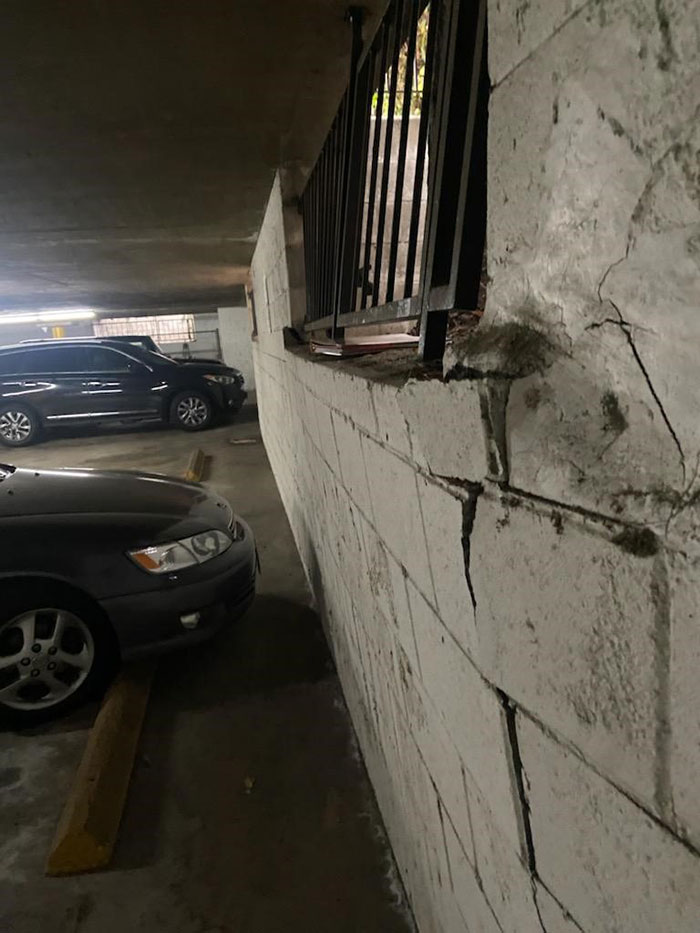
Image credits: AlphaStructural
#2
This is a pretty wicked stilt home we inspected this past week. Retrofitting these for earthquakes is one of our many specialties.
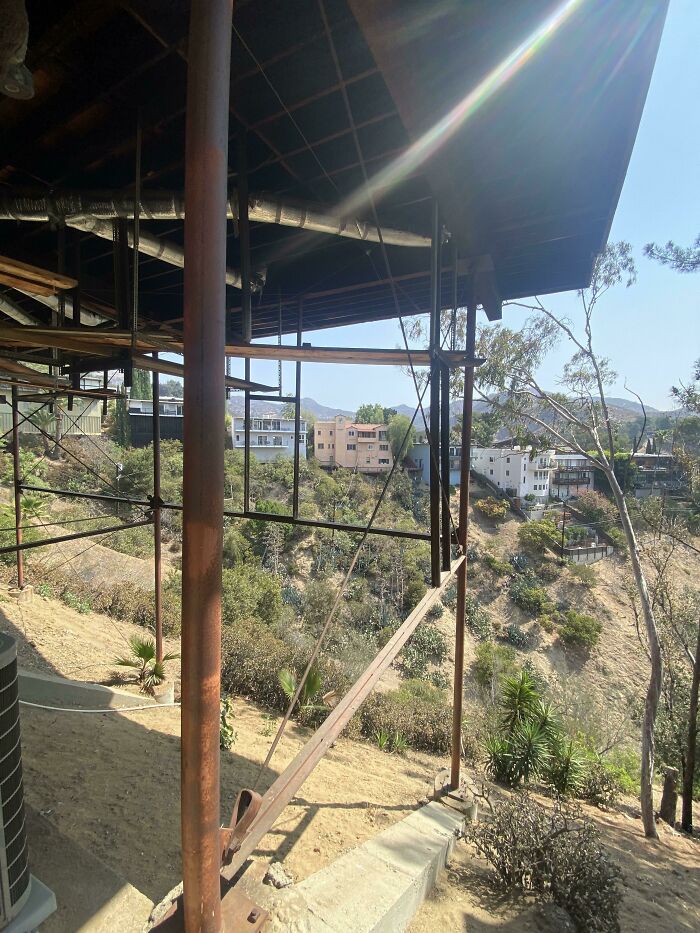
Image credits: AlphaStructural
#3
The brick and mortar piers are literally turning into dust. Not something you want holding up your entire house.
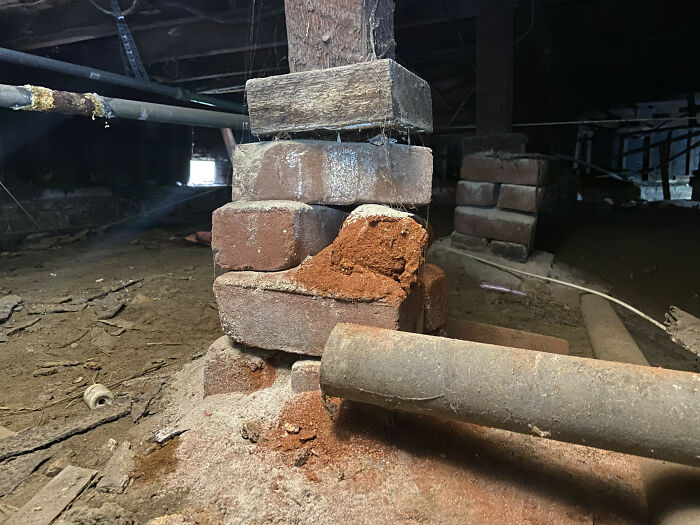
Image credits: AlphaStructural
I’ve personally had the pleasure of having some great in-depth talks with some members of the Alpha Structural team in the past. They’ve been more than kind to explain the ins and outs of their jobs, detail some of the risks they face, and generally help Bored Panda delve into the (sometimes shaky) world of structural inspection. The overwhelming feeling that I got is that this is far more than ‘just a job’ for the team: it’s a calling.
In March 2020, Derek Marier from Alpha Structural told Bored Panda about the “most nightmarish inspection” they’d done that by that point that year. It was a visit to a property in Portuguese Bend down on the Palos Verdes Peninsula. “First off, because of soil conditions and high landslide risks, not much structural work can be performed there," Derek started.
#4
Anyone want to step foot on this balcony?
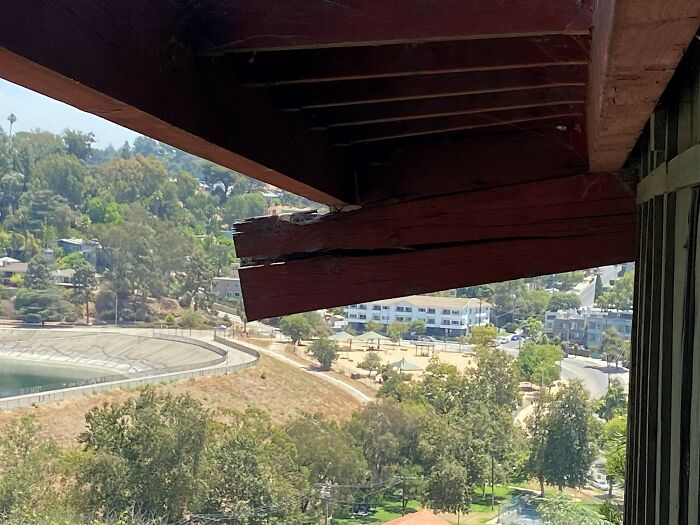
Image credits: AlphaStructural
#5
Who knows what's going on here?
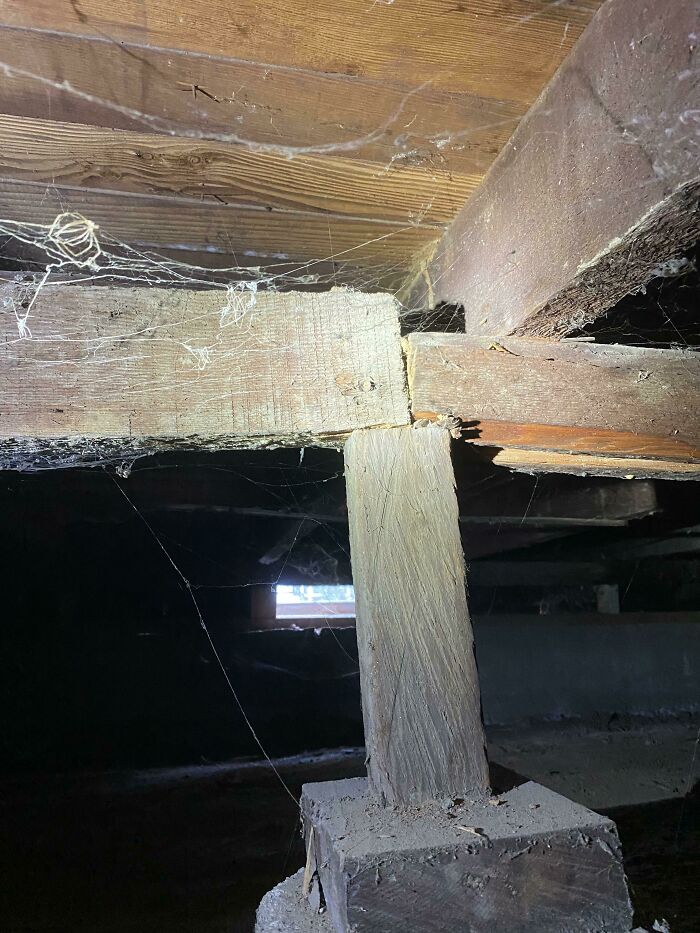
Image credits: AlphaStructural
#6
Here's a concrete pier practicing for its role as the Leaning Tower of Pisa.
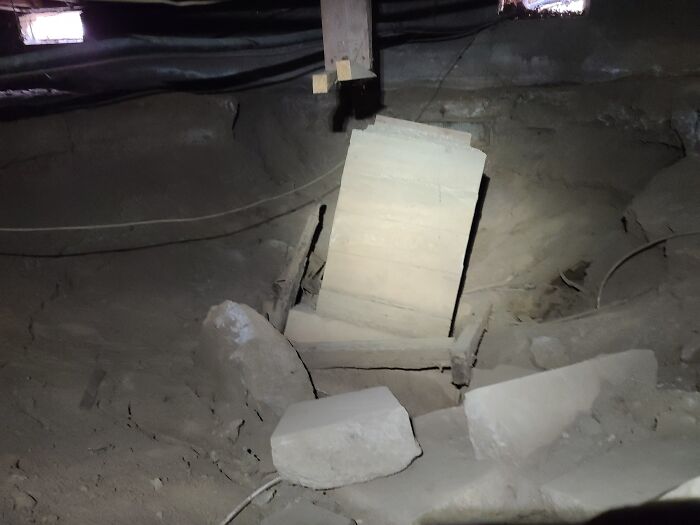
Image credits: AlphaStructural
"The home had a very interesting foundation system made up of screw jacks, steel beams, and cribbing (commonly used for temporarily lifting a structure while work is being done underneath). The front portion of the deck and home was sinking and unfortunately, the homeowner can’t really do much about it. It could have toppled over at any given moment and that’s why the 'nightmarish' description fits well," Derek detailed one such truly nightmarish case the Alpha Structural team dealt with.
Structural inspectors take safety very seriously: they take all the necessary precautions to keep their employees safe while out on the job. Derek listed that inspectors wear crawl suits, masks, gloves, and steel-toed boots. They also take many other forms of safety precautions.
#7
Here is a brick pier that's sitting dangerously close to a big hole in the ground. Something tells me the homeowner will start to feel some dipping in the floors soon!
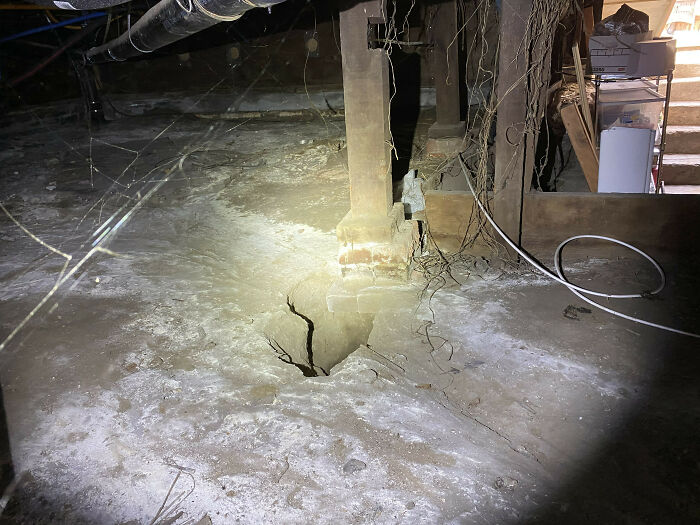
Image credits: AlphaStructural
#8
You are looking at the worst framing rot that we have ever come across on an inspection. You can't even touch this wall without the whole thing falling apart. Just look at the insulation around it! You know it's really bad when the studs begin to look like fractured vertebrae.

Image credits: AlphaStructural
#9
We weren't able to perform a proper torque test on this bolt... but something tells me we didn't have to.
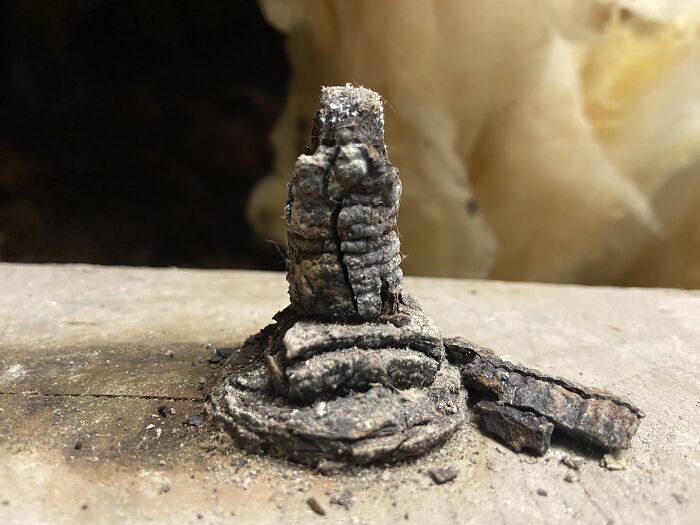
Image credits: AlphaStructural
“The chance that a building is actually going to fall over when we do our work is slim to none. Any actual danger is sniffed out pretty quick and avoided. If our guys think it’s unsafe to inspect or work on a location, they’ll make a call based on their best judgment and sometimes they choose to not do it. That’s just our safety policy!"
Sometimes, Alpha Structural’s employees will come across truly bizarre finds, like lost or forgotten items, dolls, and even skulls. “You’re expecting to locate a structural defect but end up finding something you can almost label as satanic or ancient,” Derek told me earlier.
#10
I think one more shim should do the job.
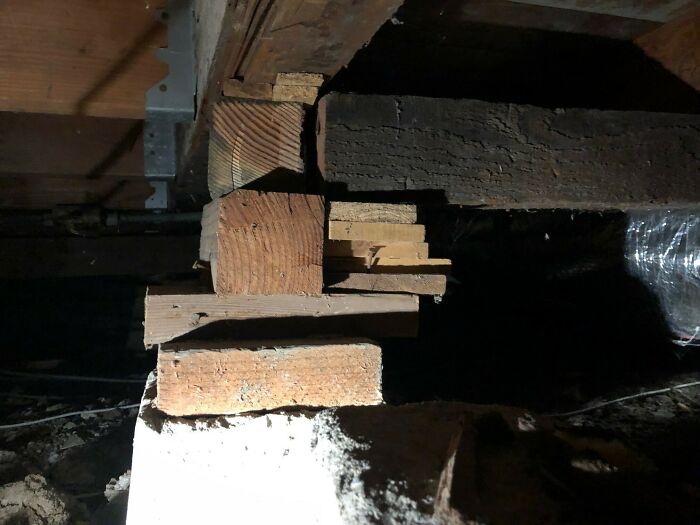
Image credits: AlphaStructural
#11
These balconies have seen better days. As you can see, the wood framing of these balconies is experiencing some deflection. This is why The Balcony Bill exists. The Balcony Bill, formerly known as California Senate Bill 721, was signed into law back in 2018. This bill requires the inspection and possible repairs on all balconies, decks, and stairs that rely in whole or in substantial part on wood structural support in multi-family residential buildings with three or more dwelling units.
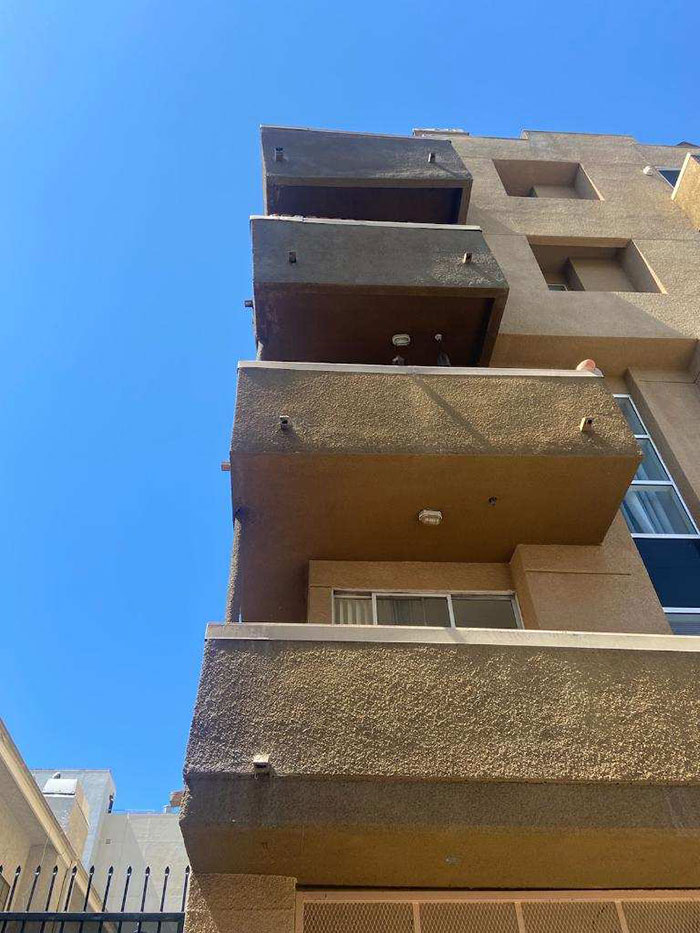
Image credits: AlphaStructural
#12
Here is yet another brick foundation we inspected this past week. We want to get as many of these replaced, or at the very least, sistered before the next major earthquake in LA. The external foundation walls of this building are bowing, and many of the bricks are falling out of place. (Image 2) Not only that, but the framing is in really bad shape and a lot of it needs to be replaced as well. (Image 3)
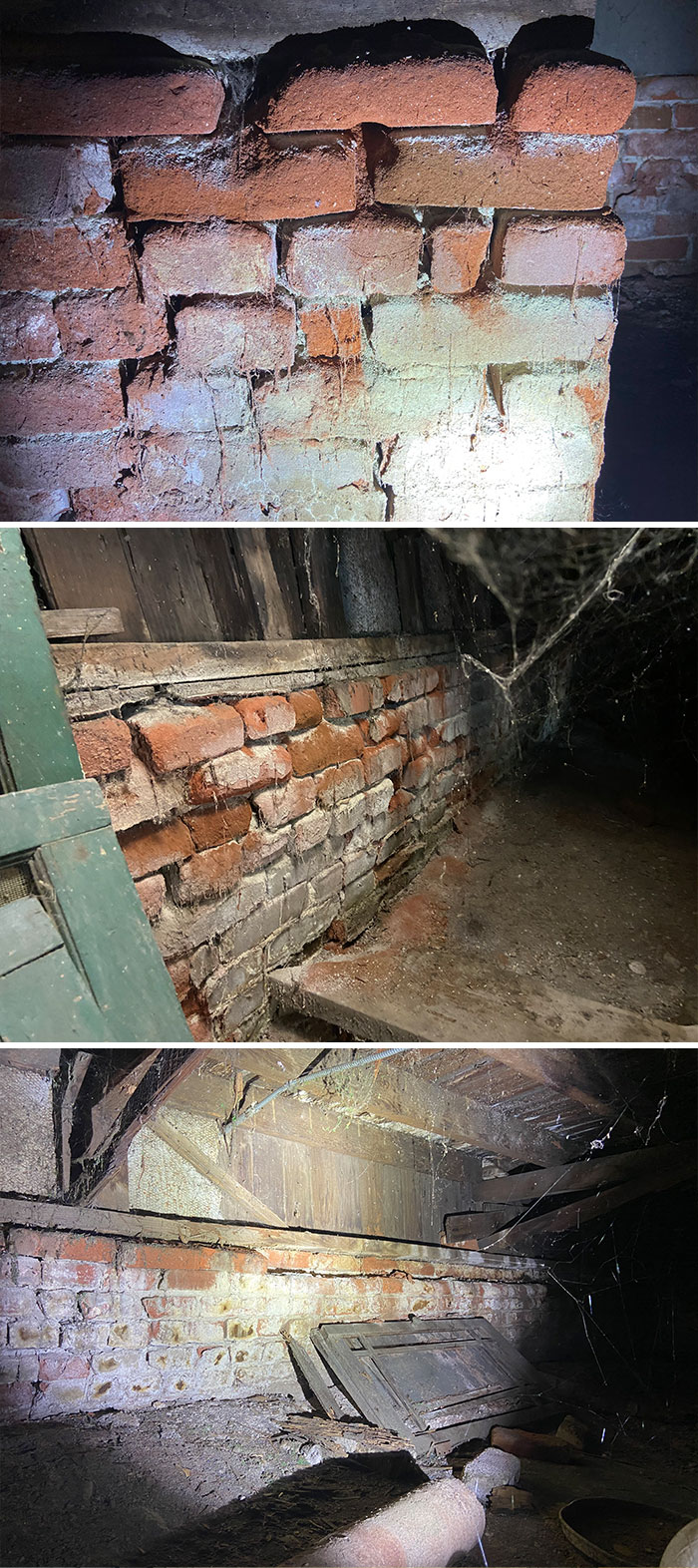
Image credits: AlphaStructural
One extremely frightening situation Derek found himself in was going into a tunnel that someone had dug under the foundation of a building. “I’ve heard horror stories of people getting trapped under houses by attempting to squirm through those gaps. That’s a nightmare in itself. Thank the lord there was no scary doll or human skull staring me in the face while I was attempting to crawl through!”
#13
This failing retaining wall won't last much longer. Some movement over the years has taken place and has caused the wall to lean into the sidewalk.
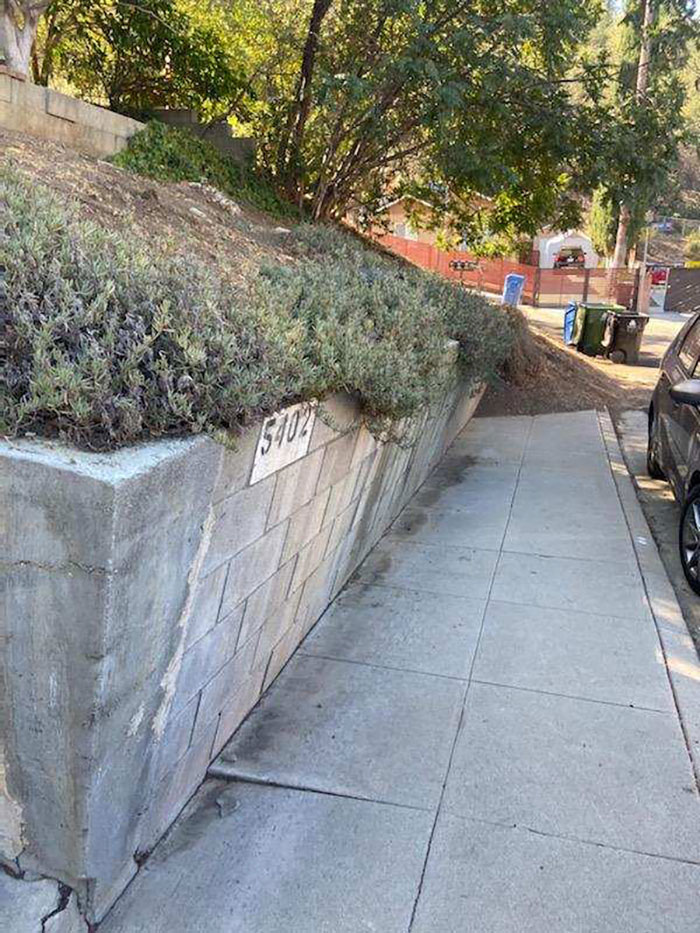
Image credits: https://imgur.com/gallery/FNIPJmC
#14
Another failing railroad tie "retaining wall" that should be replaced soon. You can see how far it has begun to lean towards the street.
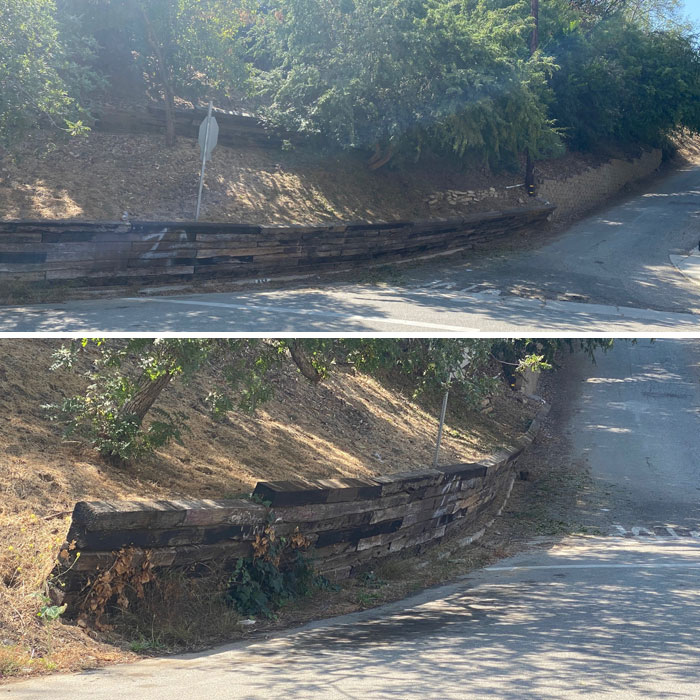
Image credits: AlphaStructural
#15
I guess they wanted an open floor plan? They took the brick wall separating the two rooms down. No permits, no contractor, just a man and his trusty hammer.
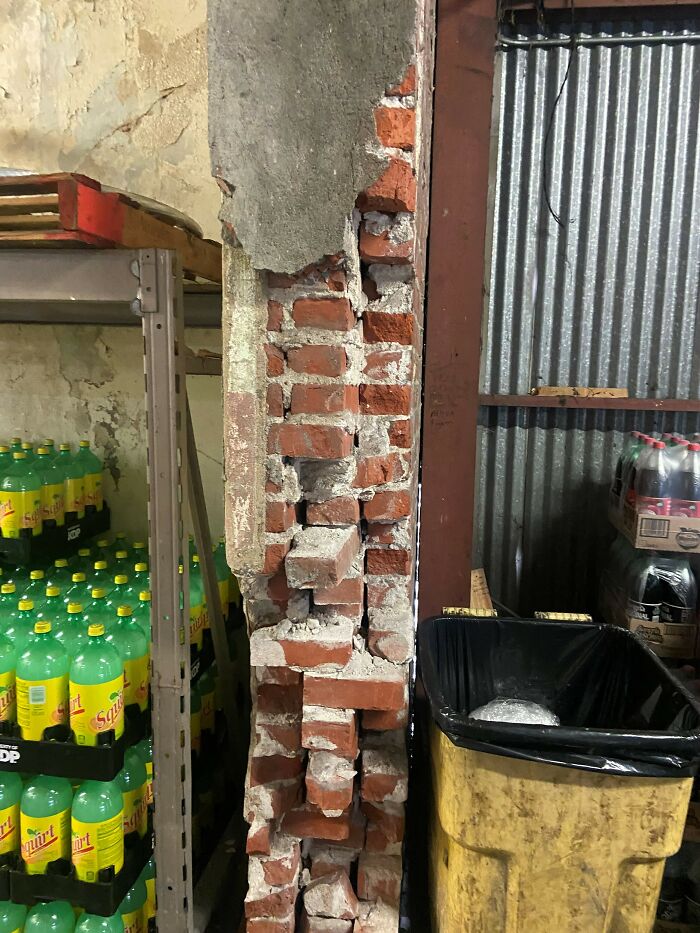
Image credits: AlphaStructural
#16
It's always nice when I don't have to crawl into a crawlspace but, these stairs are pretty frightening.
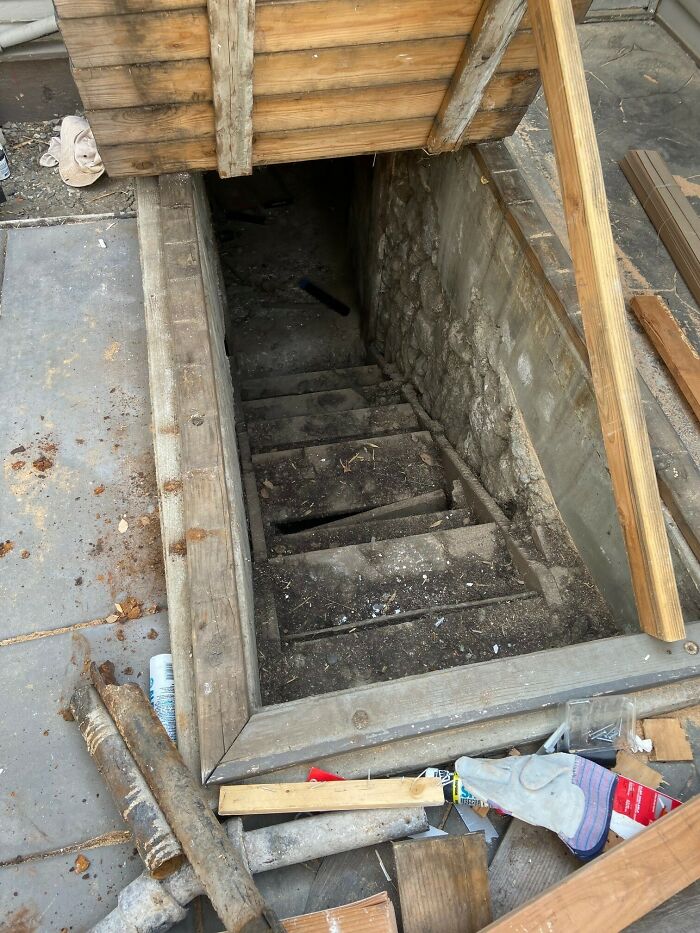
Image credits: AlphaStructural
#17
"How do you know if your wood is rotting?" This is how.
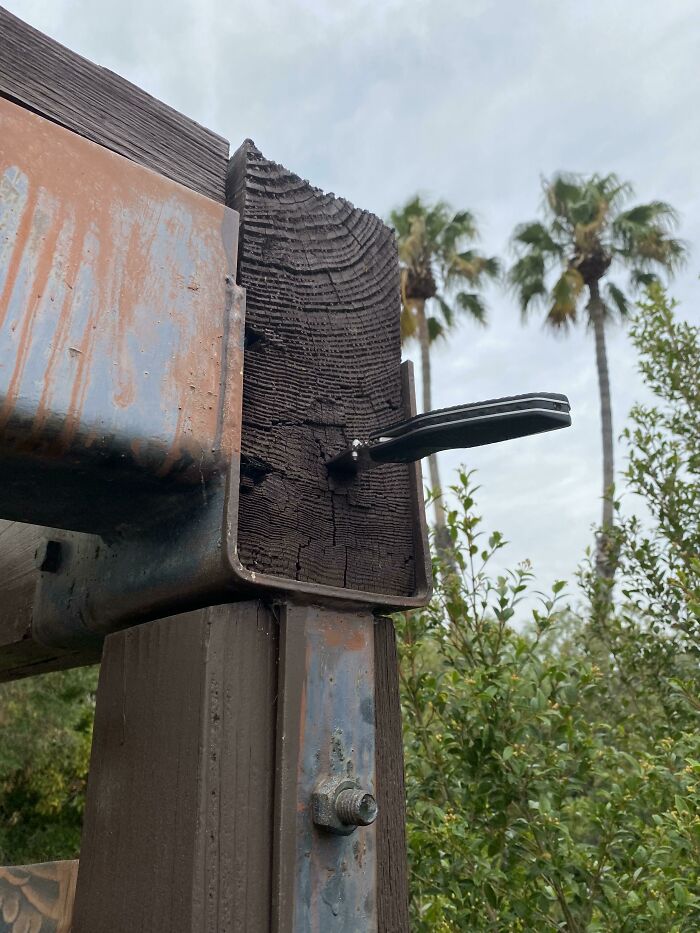
Image credits: AlphaStructural
#18
Whole lotta issues with this... Just slightly separating from the structure...
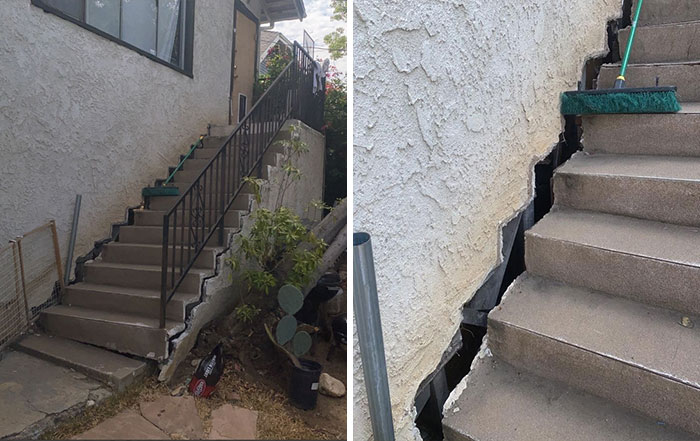
Image credits: AlphaStructural
#19
There should not be a space here. Never good news when you see stem walls separating at the corner.
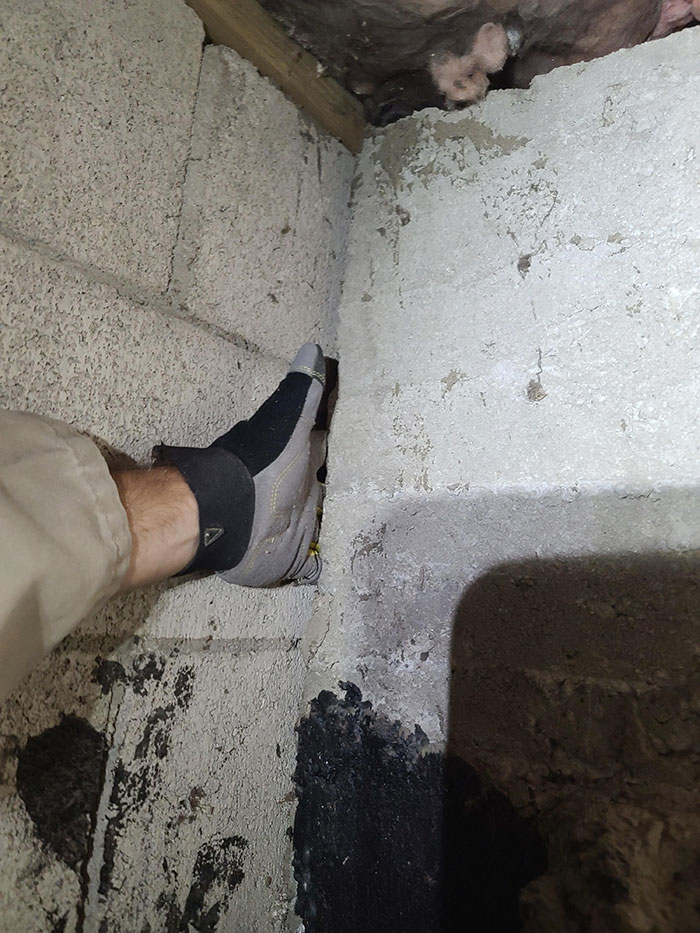
Image credits: AlphaStructural
#20
And for my next trick I will levitate this post...
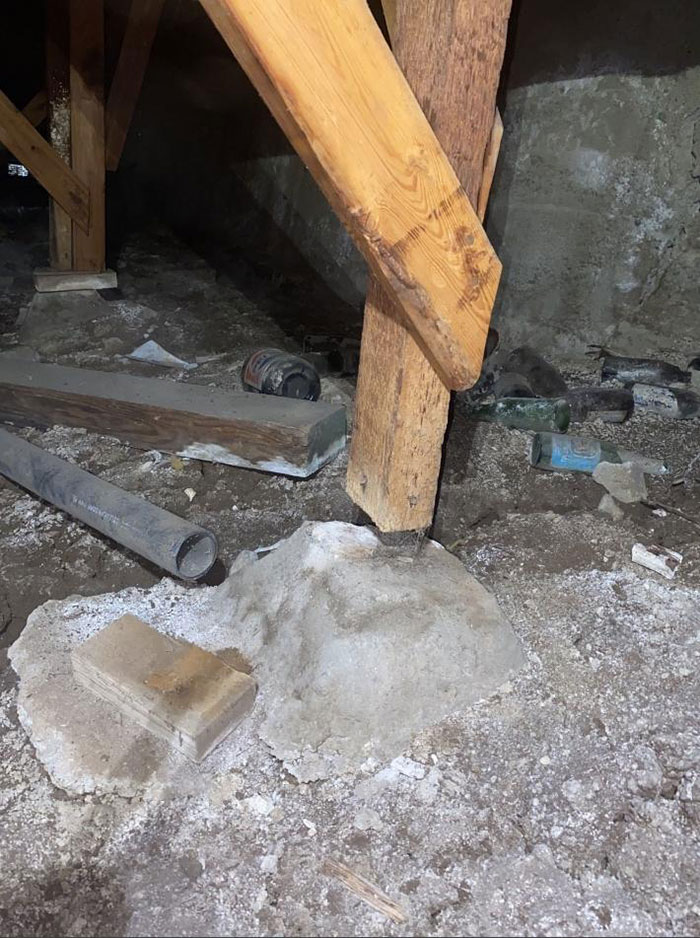
Image credits: AlphaStructural
#21
Here we have some expansive soil, clearly affecting the foundation already.
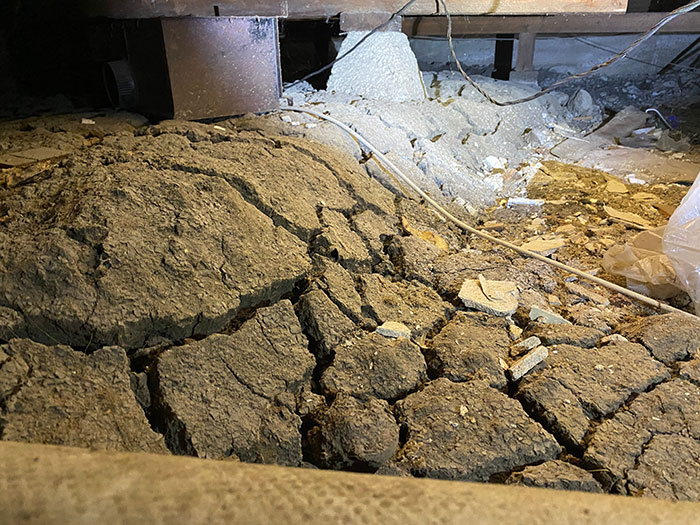
Image credits: AlphaStructural
#22
Wood should never crumble away like this.
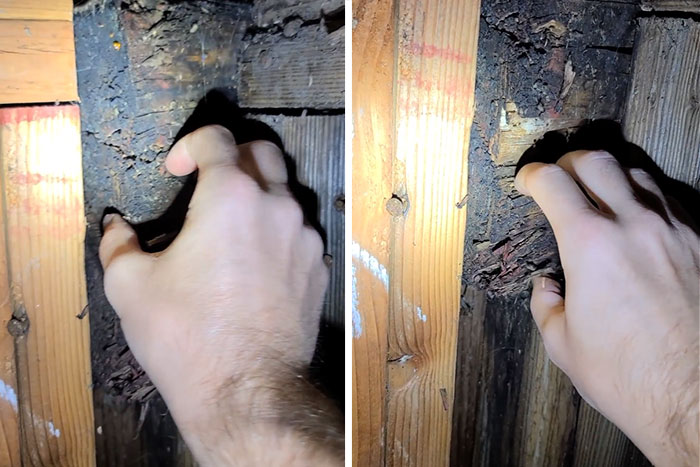
Image credits: AlphaStructural
#23
Here's a brick foundation where the mortar has degraded almost entirely. Only a small section (in the middle of the brick wall) has solid mortar. Replacing or sistering this foundation would be the only solution for this homeowner.
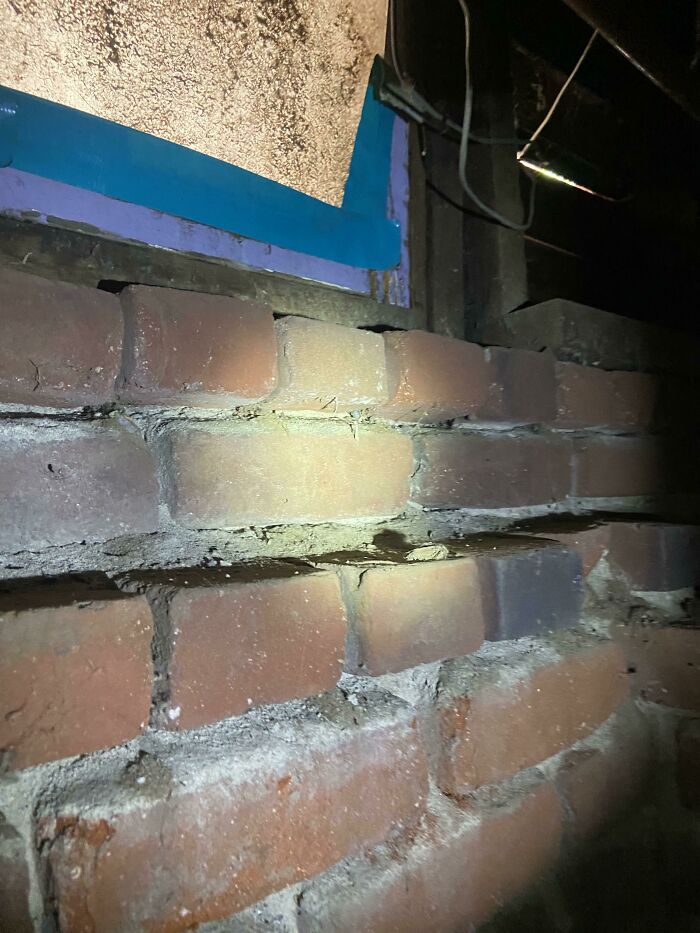
Image credits: AlphaStructural
#24
A customer called us in because of this crack running off the corner of their door, which is never a good sign and points in the direction of foundation problems.
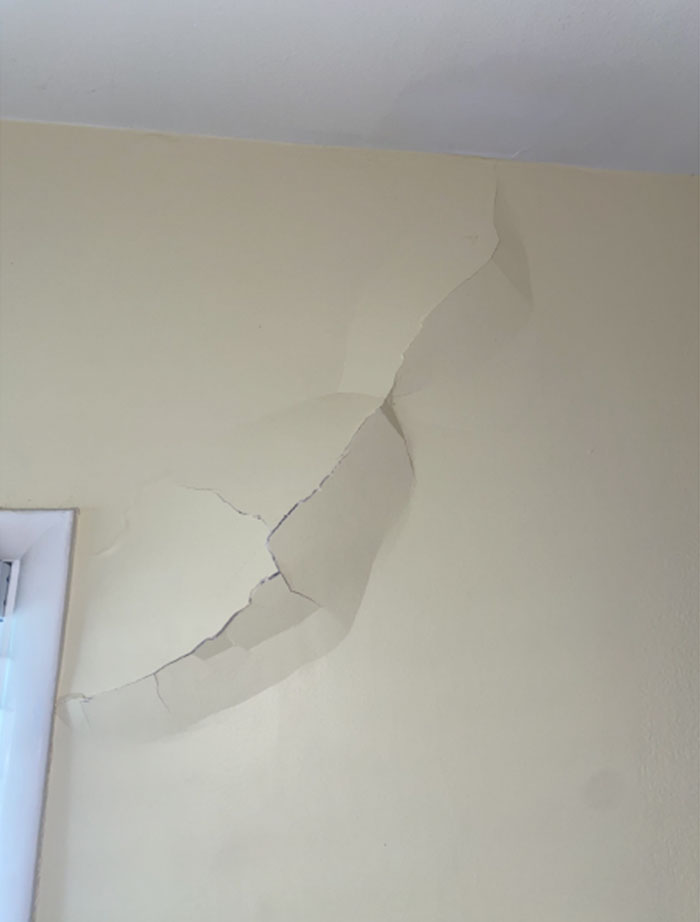
Image credits: AlphaStructural
#25
Has anyone seen any of the many videos of balconies failing? This is one of the main reasons. Spalling is when the rebar inside of reinforced concrete has started to rust and expand due to water penetrating the concrete over a large period of time. This is not only dangerous for the people who step on the balcony but the people beneath as large chunks of concrete can fall off of at any moment. Spalling significantly decreases the structure's ability to safely carry its intended loads. Wood rot is another one of the main reason for balcony failures.
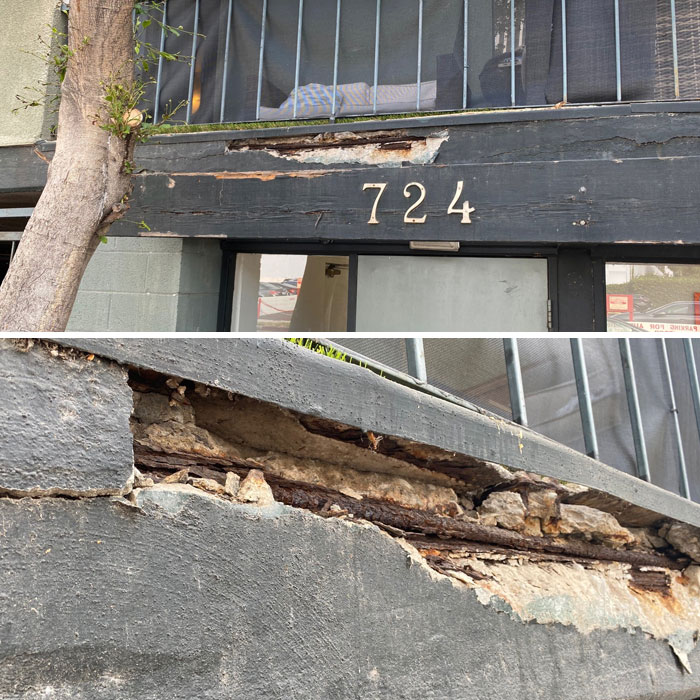
Image credits: AlphaStructural
#26
Larger cracks like this found outside the home may mean the foundation has shifted or sunk. Cracks wider than one-quarter inch could indicate problems with the home’s structural integrity. Once the structural problem is fixed, homeowners can make the cosmetic repairs. Looks like the stem wall has a large crack and is separating from the rest of the stem wall and is starting to rotate away. Time to be replaced!
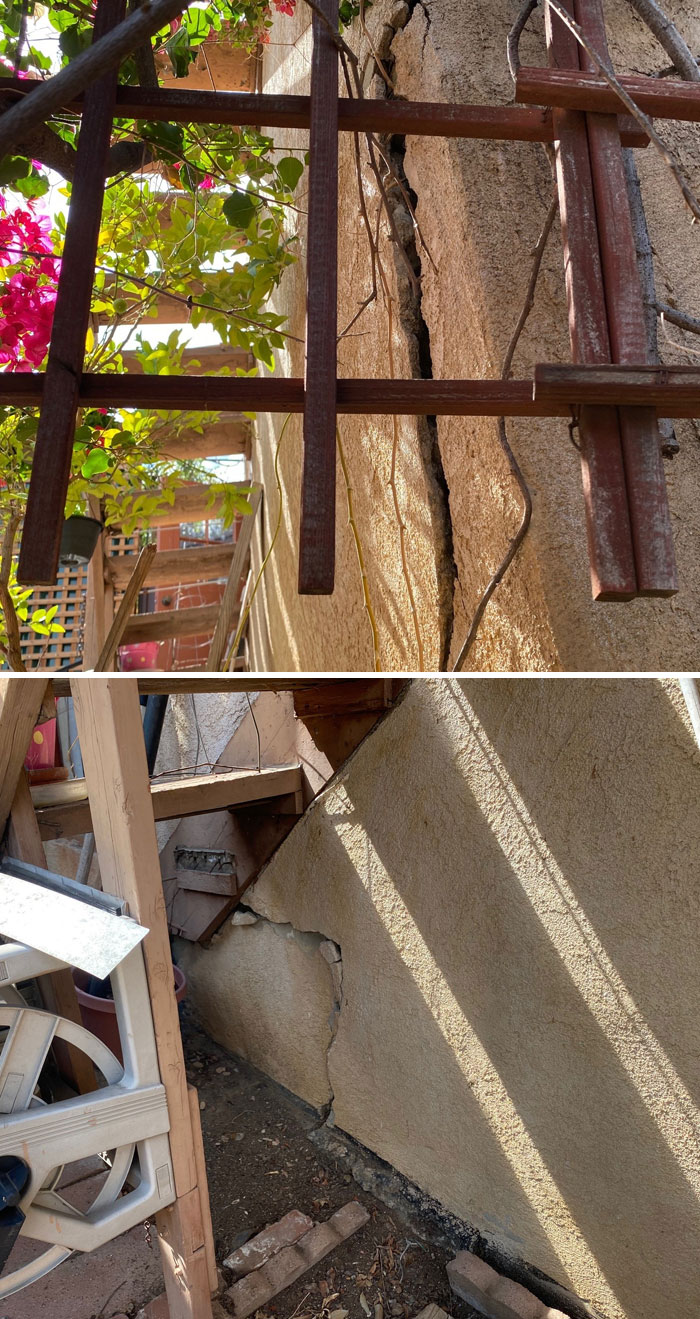
Image credits: AlphaStructural
#27
When the retaining wall is built of concrete blocks, the cracks may look like stair-steps. Stair-step cracks are a sign that your block retaining wall is failing. Improper drainage could be the culprit of this crack. The soil behind the wall is soaked with water and this applies pressure to the wall.
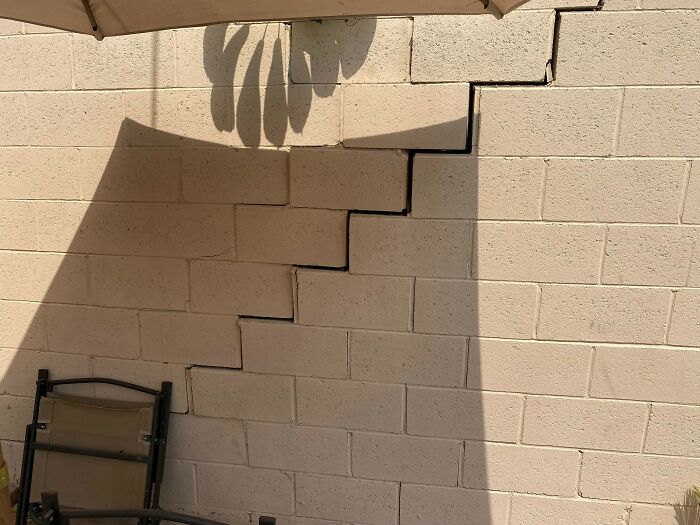
Image credits: AlphaStructural
#28
A portion of the retaining wall has separated from the rest of the wall. This will only get worse as time goes on if not fixed. Here you can see how much the wall has been pushed away from the top portion of the wall.
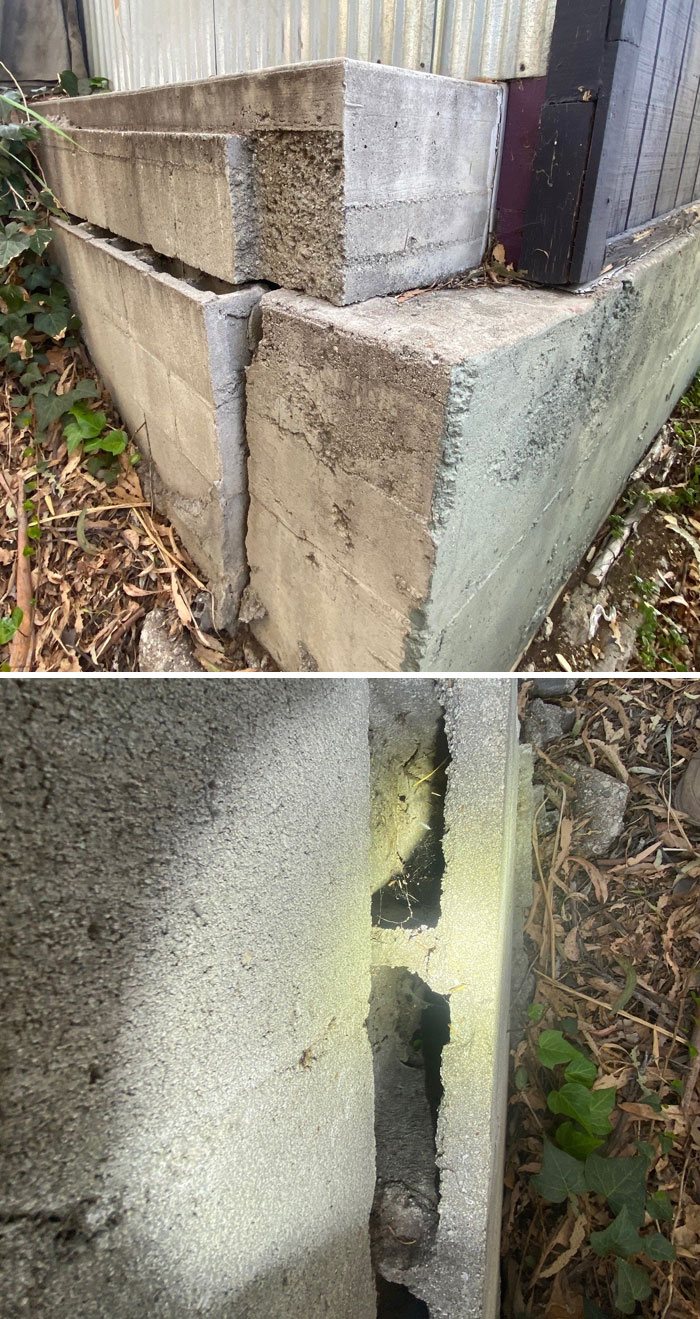
Image credits: AlphaStructural
#29
This illegal addition was in really bad shape.
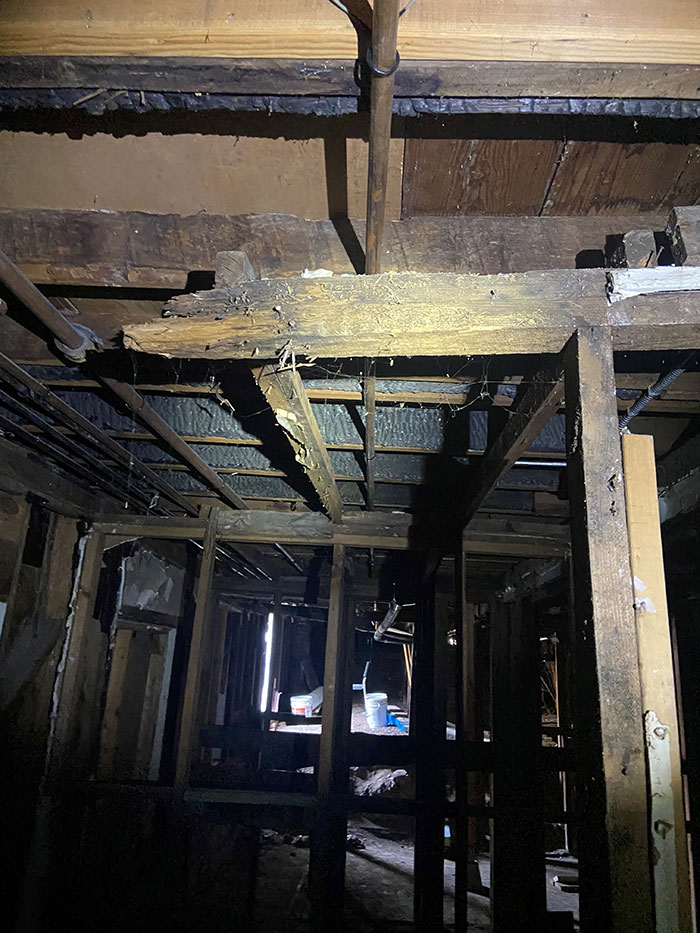
Image credits: AlphaStructural
#30
This two-story home is being supported on one layer of brick... one layer of brick.
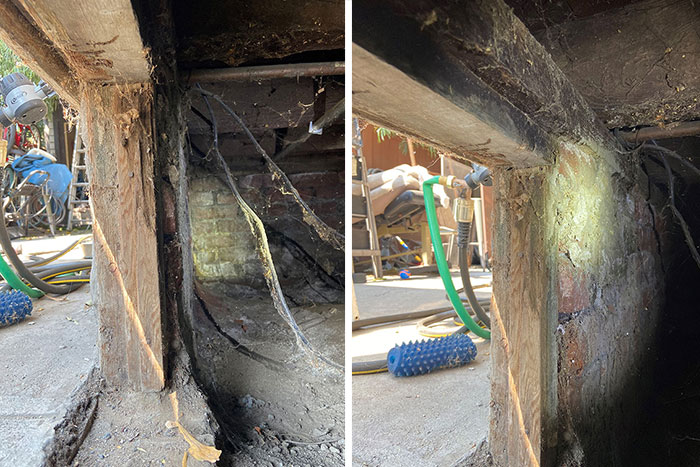
Image credits: AlphaStructural
#31
This is what no steel in the concrete and moving soil will do to your foundation. Someone placed a few shims in there to level it all out.
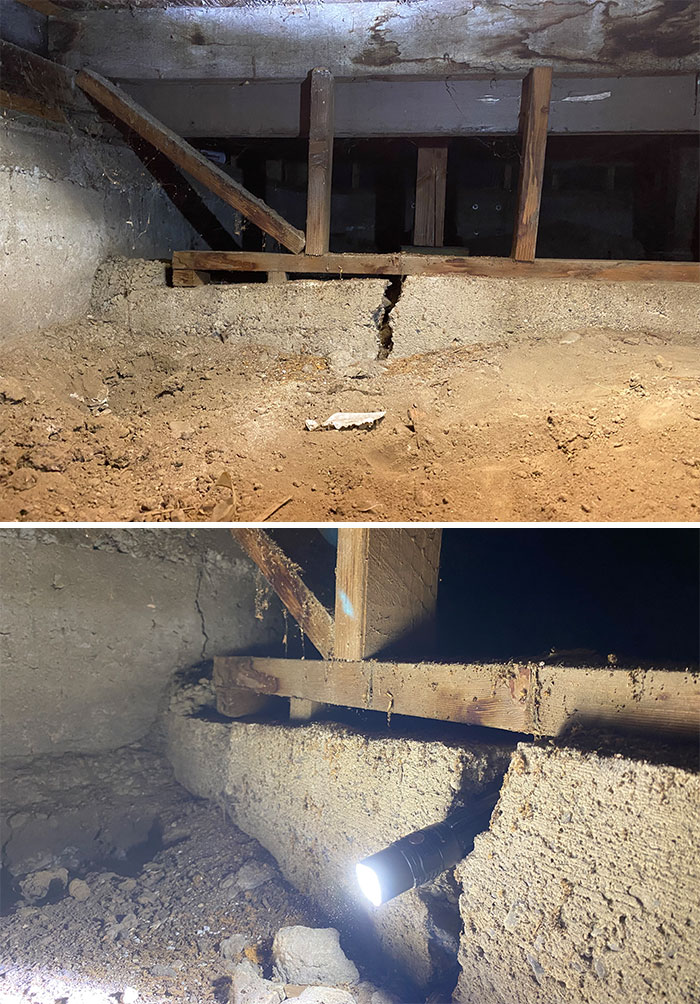
Image credits: AlphaStructural
#32
Was it opposite day when this was installed? This is a long concrete pier with a wooden shim acting as its post... Pretty strange.
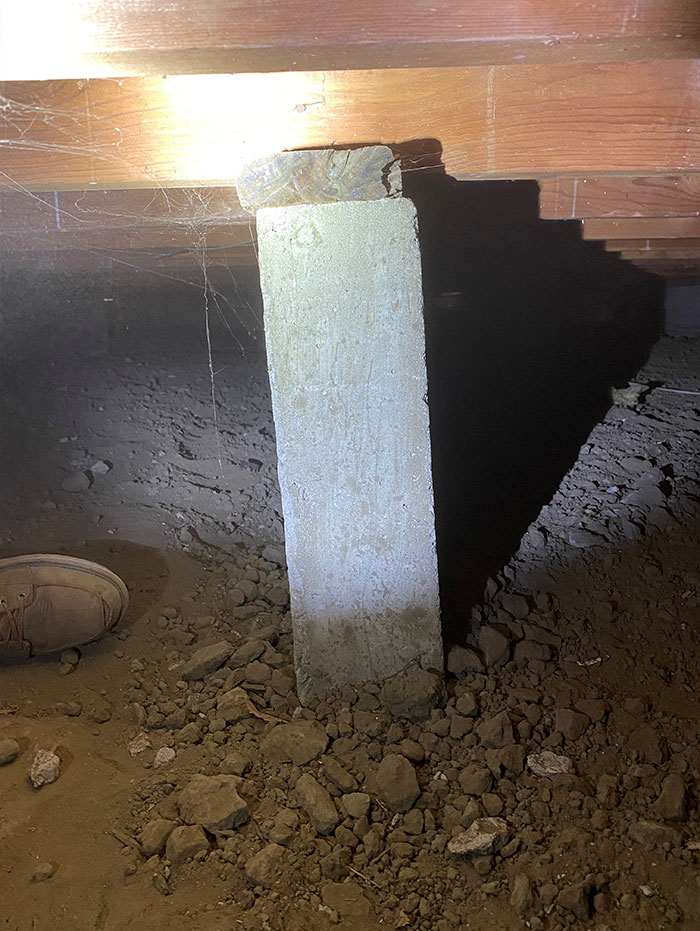
Image credits: AlphaStructural
#33
Don't underestimate the power of tree roots.

Image credits: AlphaStructural
#34
These photos are of severe spall damage underneath an old concrete structure in Los Angeles. This kind of structural flaw occurs after water penetrates the concrete, causing the steel to rust and expand. This breaks apart the concrete and reduces the strength of the area or possibly the entire structure. We shared these because we wanted owners and managers of these types of buildings to be able to recognize the potential damages that could compromise their structures. Recently we have been inundated with calls from building owners who are fearful that their buildings could collapse like the condos in Miami. The issues seen in these photos are similar to what was discovered in Miami, among other things. Whether it's in the ceilings, walls, floors, or columns, and either in the interior or exterior of the structure, these are all signs of significant structural flaws and should always be approached promptly with properly engineered solutions.

Image credits: AlphaStructural
#35
Here's some gnarly spall damage on the underside of a large condo building in LA.
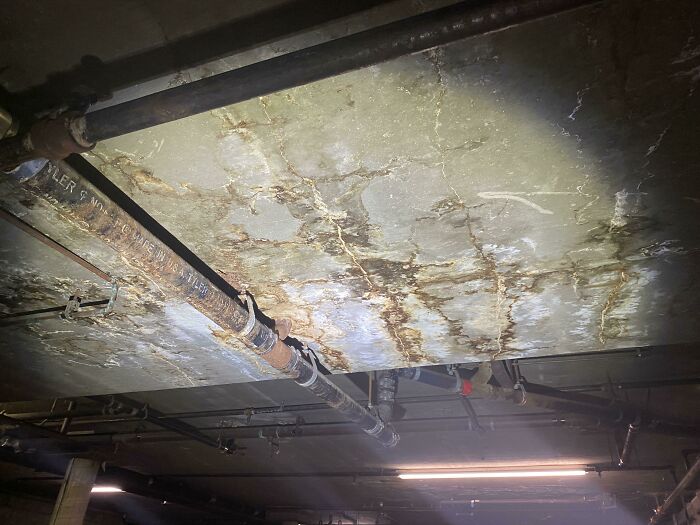
Image credits: AlphaStructural
#36
This is a concrete and brick structure with visible spall damage on the exterior. It's also causing some structural cracking on the outside where the concrete isn't as exposed. This will be a good one to document and share if we do the work!
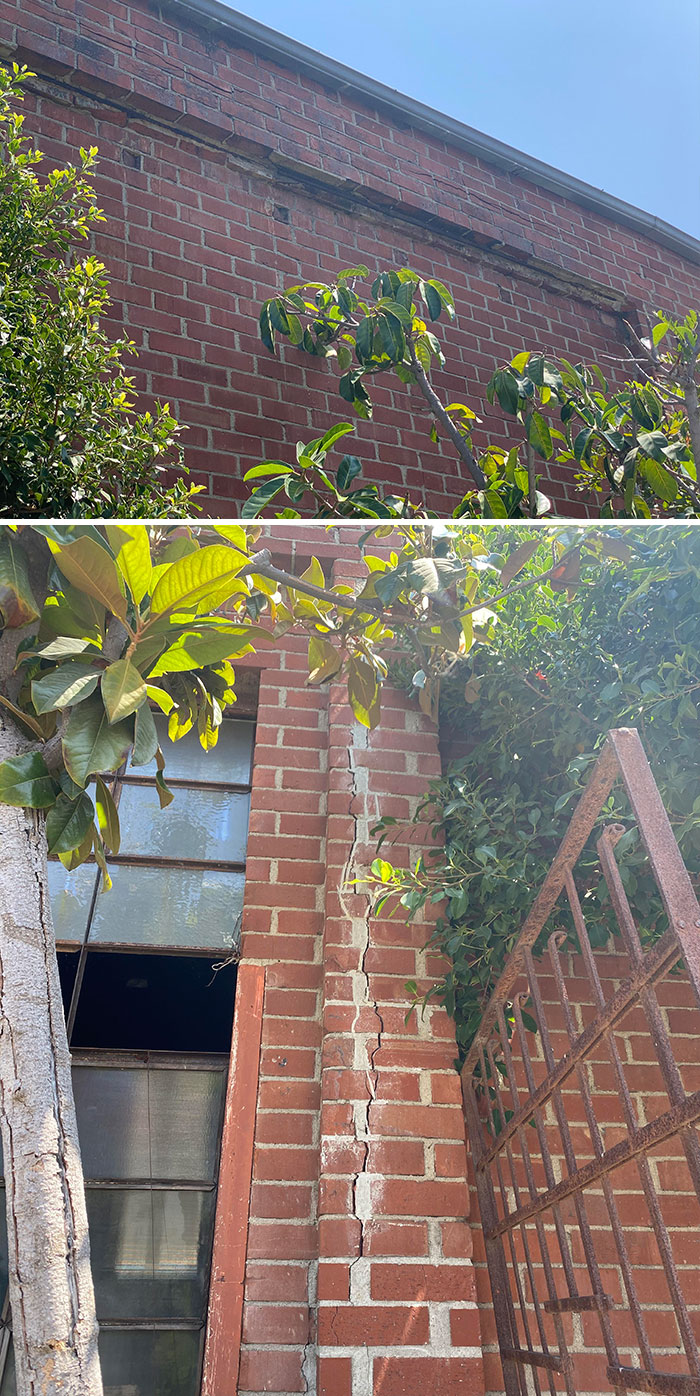
Image credits: AlphaStructural
#37
These photos are from a home we inspected that was built in 2009. You would think that because it's newer construction the home would be a good shape. Well, this should give you a better understanding of how damaging water leaks can be if they go undetected. Nearly the entire subfloor is rotted from water damage and multiple joists are hanging down from rot. It took less than a decade for this to occur, so not all homes with significant damage are 100 years old. Large puddles of water had to be avoided during the crawl as well. (Image 3) Here you can see two joists hanging down after snapping in half from water damage. (Image 4) This is probably the nastiest of all the damage. That is not paint. It's possible that the entire subfloor needs to be replaced. (Image 5)

Image credits: AlphaStructural
#38
Somebody had previously attempted to fill the cracks, but this only further harms the concrete and can cause spall damage. If this goes unhandled, it will create a big problem for the owner and the residents!
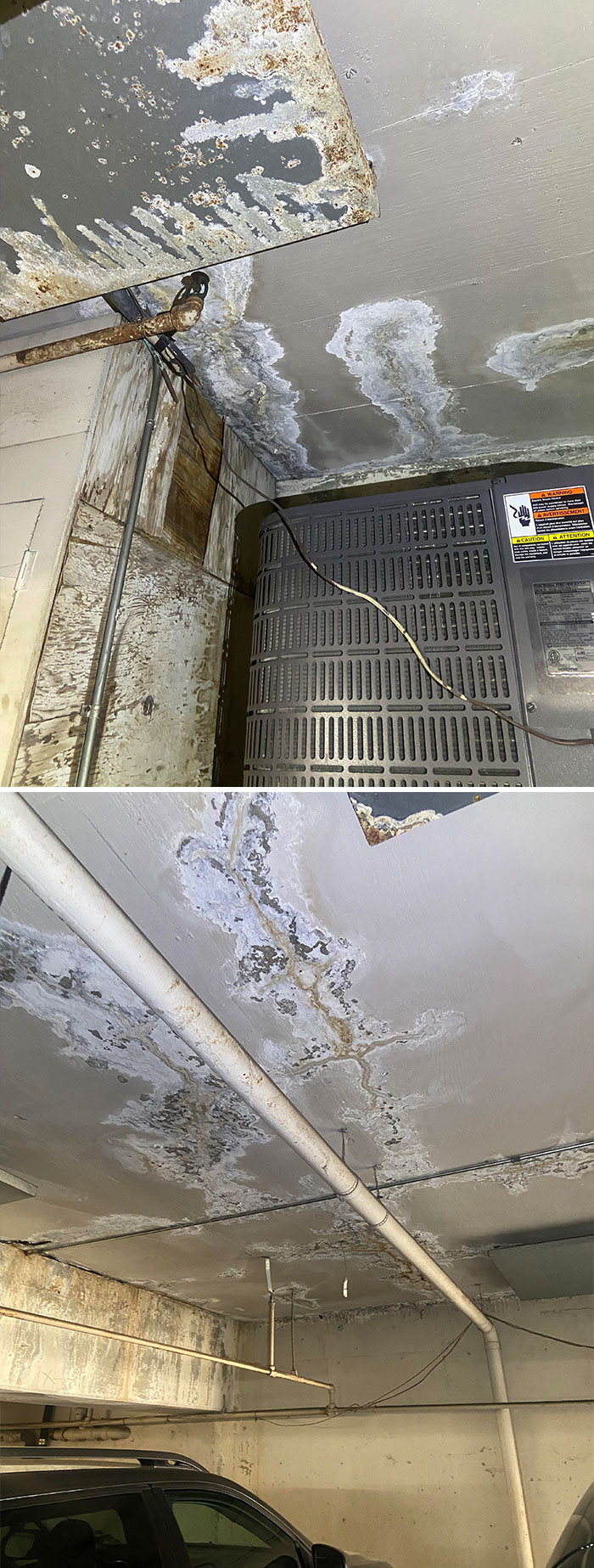
Image credits: AlphaStructural
#39
There appears to be a cave system leading down underneath this home's foundation.
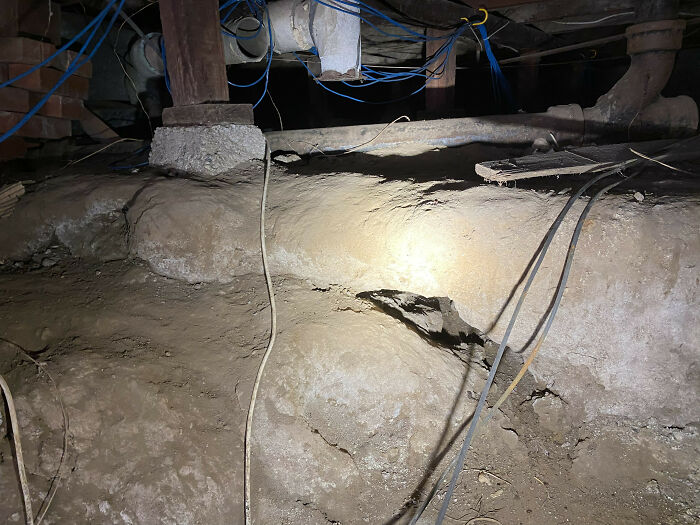
Image credits: AlphaStructural
#40
This wooden post seems to be sitting on a bed of shims, connected to a rusting baseplate.
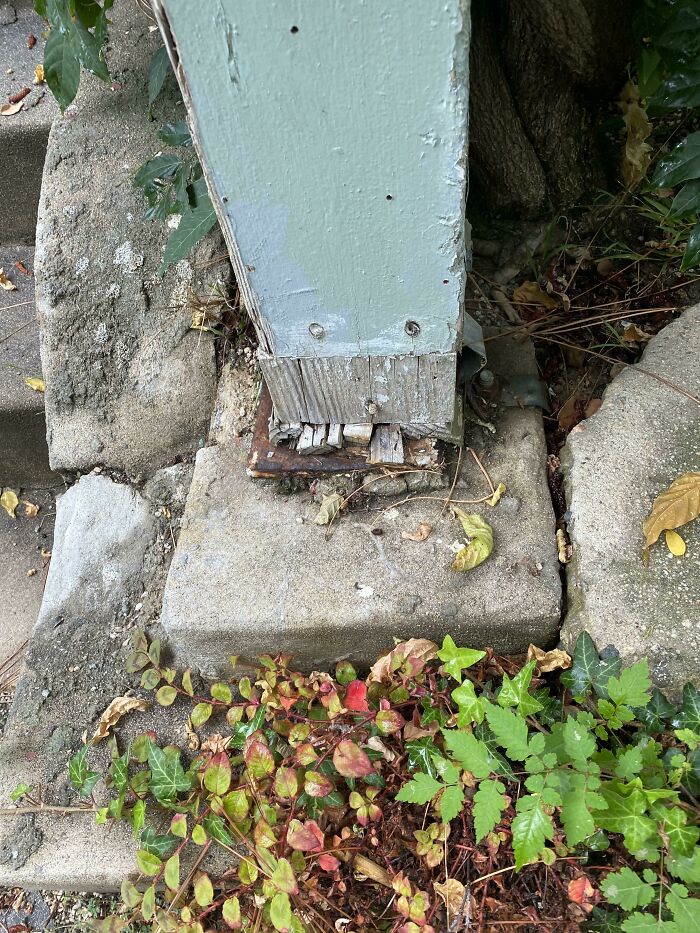
Image credits: AlphaStructural
#41
Some of the piers weren't even in contact with the posts.
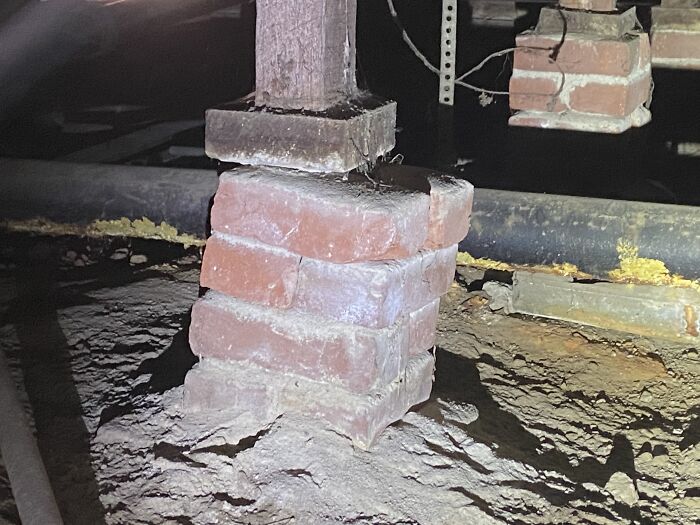
Image credits: AlphaStructural
#42
The old lathe and plaster ceilings are sagging, looking like it's about to collapse.
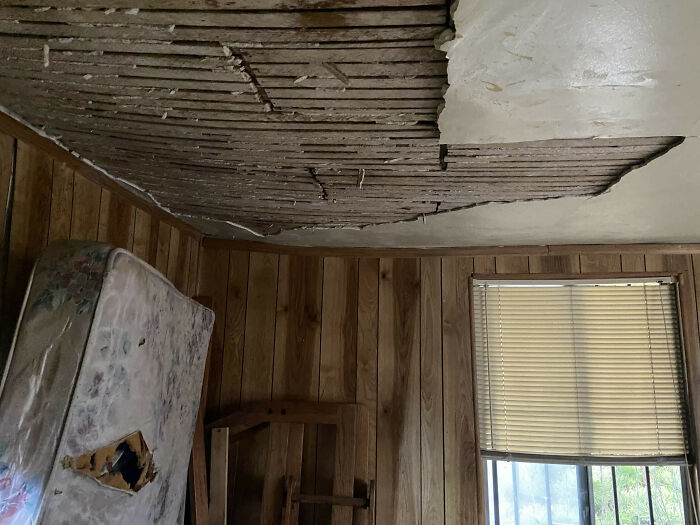
Image credits: AlphaStructural
#43
Here is an early 1900s home with a very brittle brick foundation. These large interior cracks likely formed after years of settlement and degradation of the foundation.
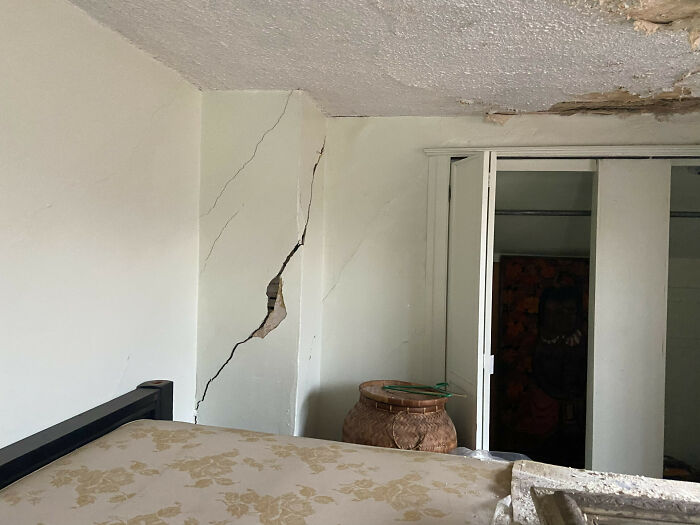
Image credits: AlphaStructural
#44
Follow me into my office.
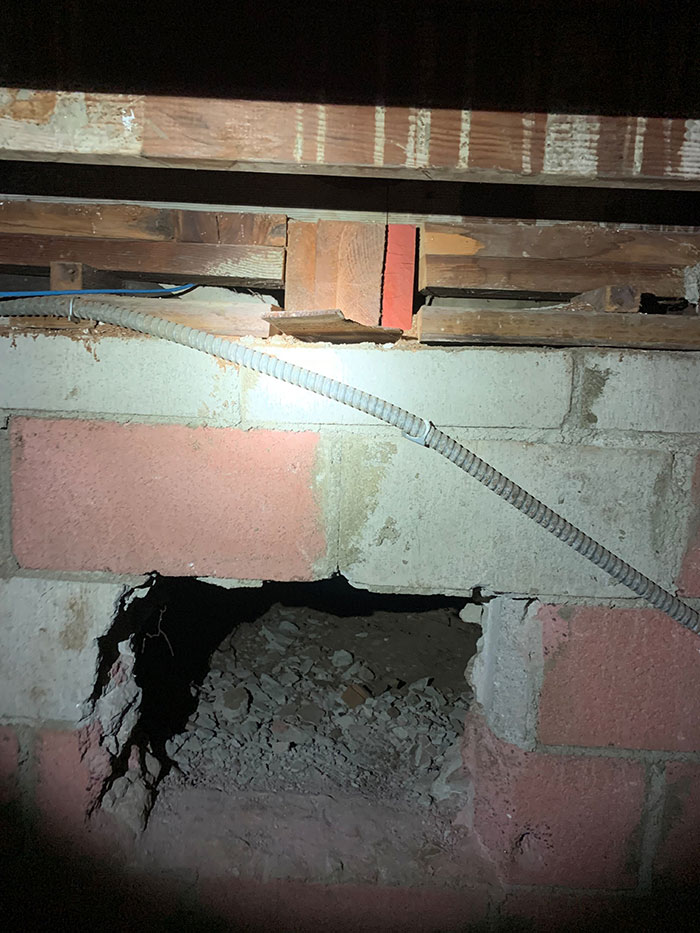
Image credits: AlphaStructural
#45
Here is a leaning retaining wall that is breaking away from a garage structure. Notice the large wooden beam that is wedged in there to help hold the wall back. You can see large cracks at the bottom of the wall where the initial fracture took place. (Image 2) Here's an image from the inside of the garage. The roof is also rotting and is just falling apart as the wall leans outward. (Image 3)
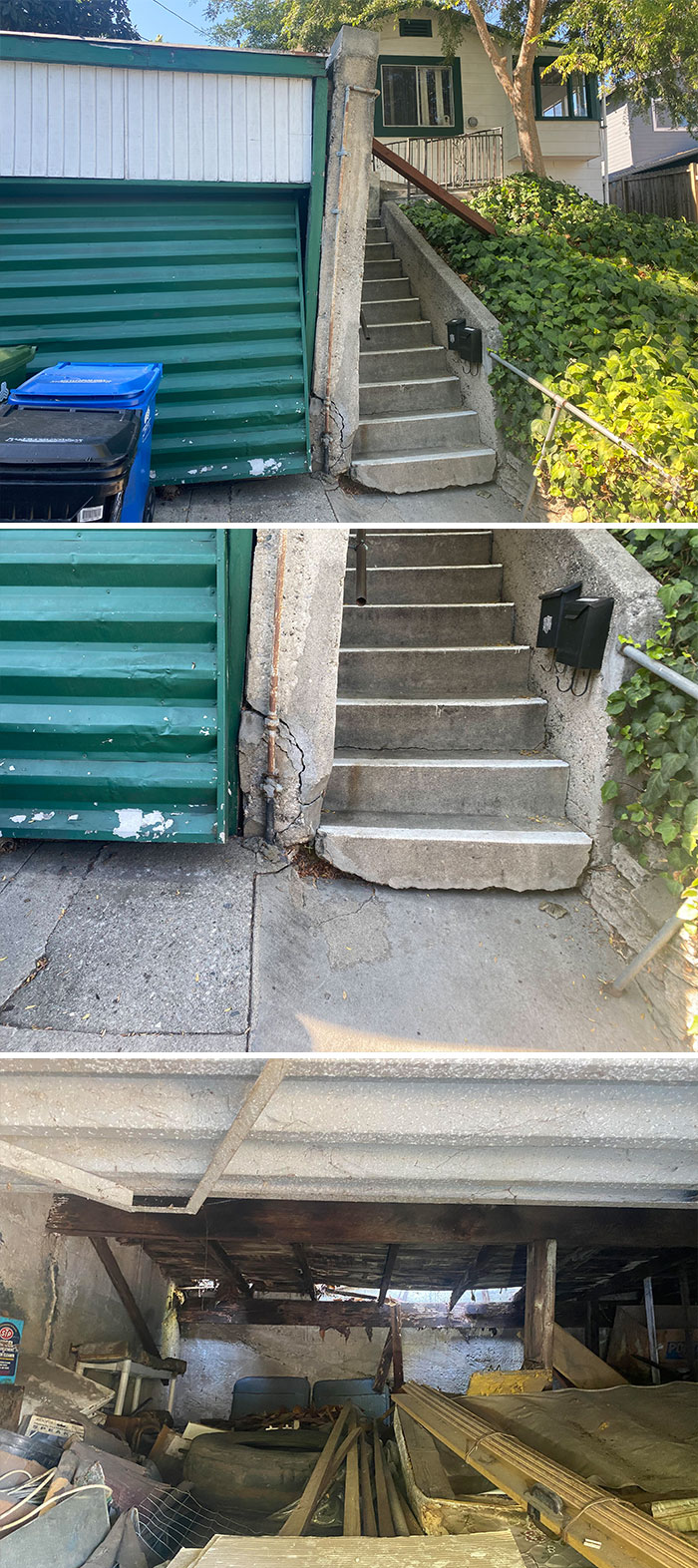
Image credits: AlphaStructural
#46
Here is a retaining wall that's partially supported by piles. The wall is now separating at the exact spot where they omitted to put more of them. Now the wall is sinking and leaning down the hill.
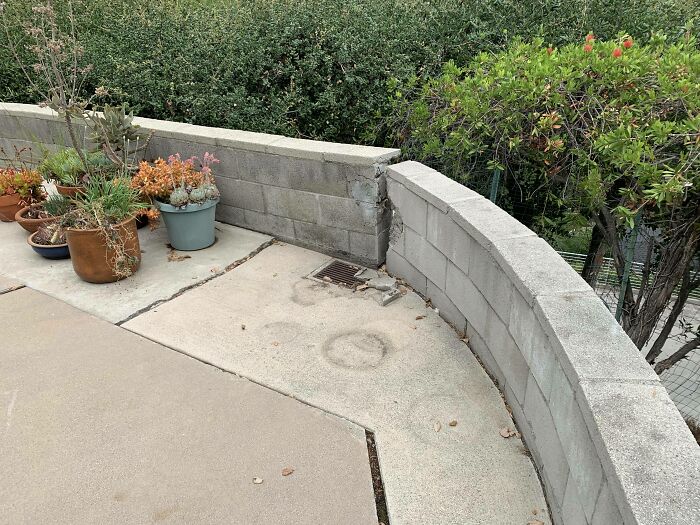
Image credits: AlphaStructural
#47
Here's an undermined concrete foundation that a plumber couldn't resist taking advantage of.
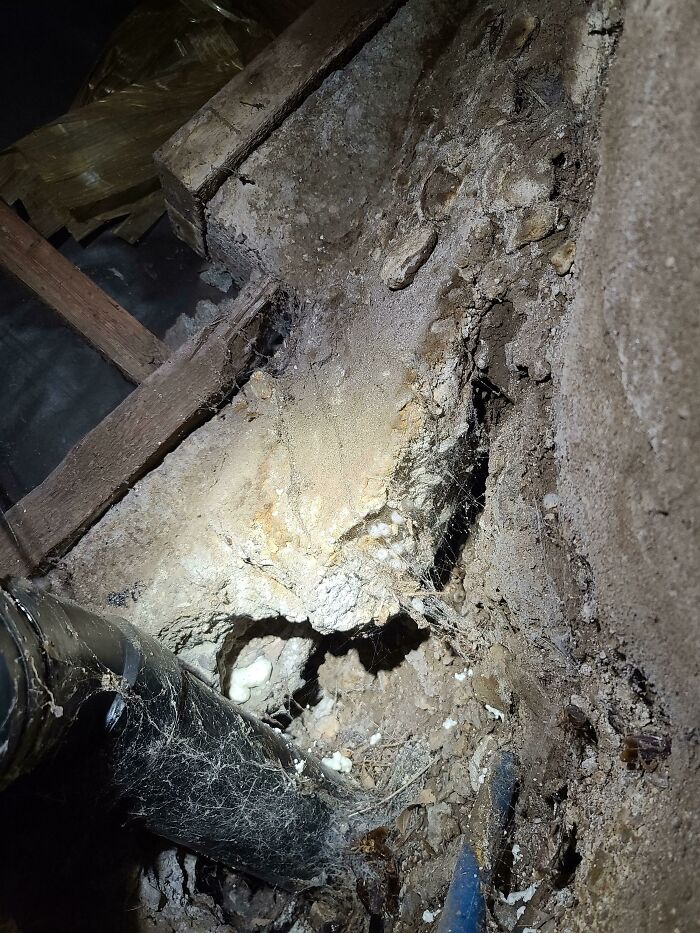
Image credits: AlphaStructural
#48
Here's a concrete masonry retaining wall that is beginning to fail. I'm sure that one more winter full of heavy rainfall would cause this sucker to come down.
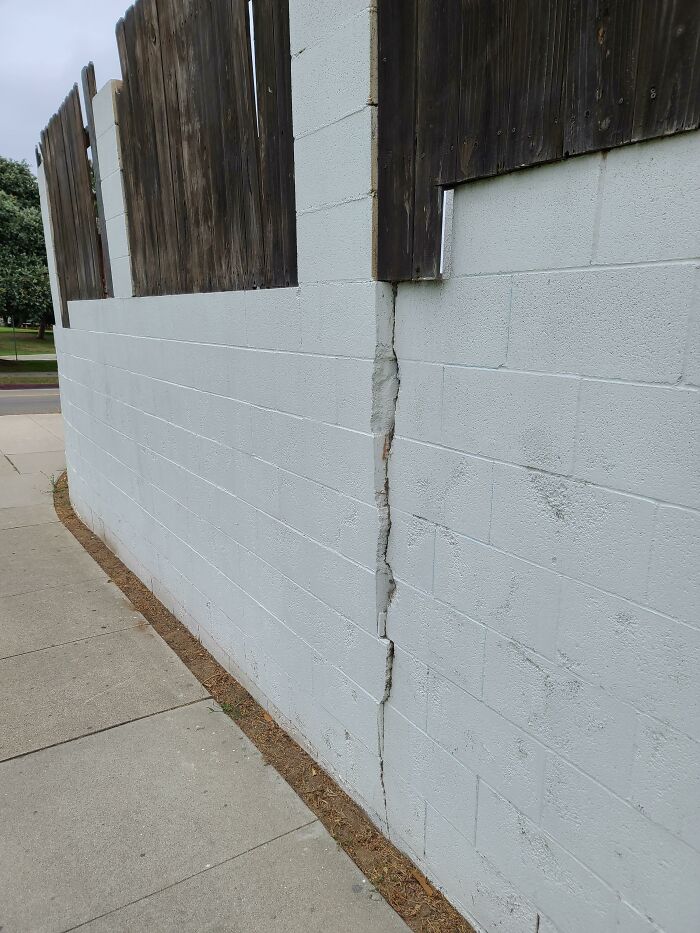
Image credits: AlphaStructural
#49
Here we have a column that's settling downward, dragging the iron fencing with it.
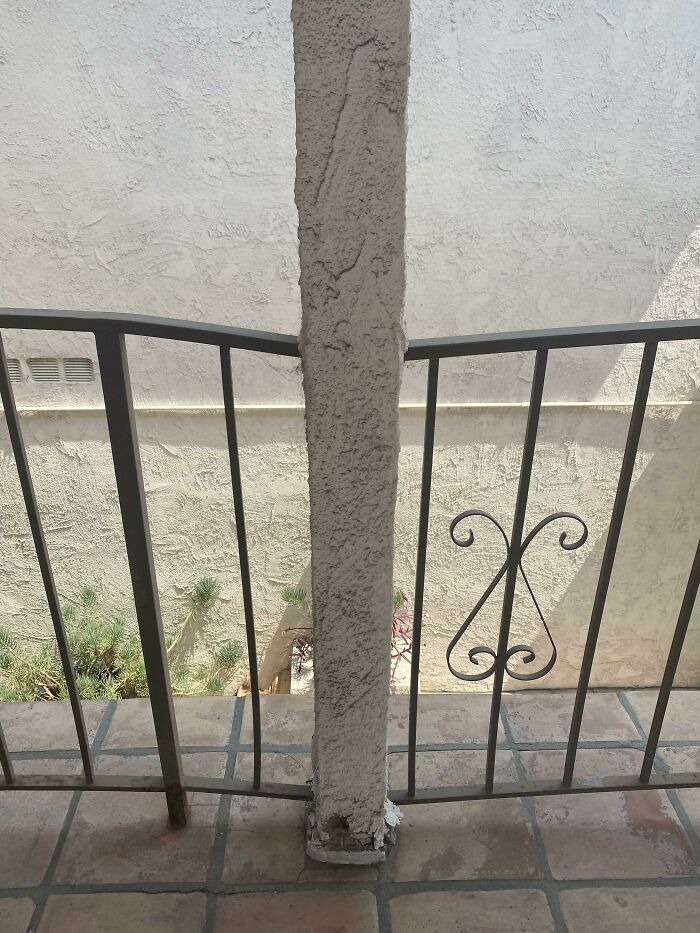
Image credits: AlphaStructural
#50
This cripple wall is rotating away from the home.

Image credits: AlphaStructural
#51
Lots of earth-to-wood contact under this home. Let the termite feast begin.
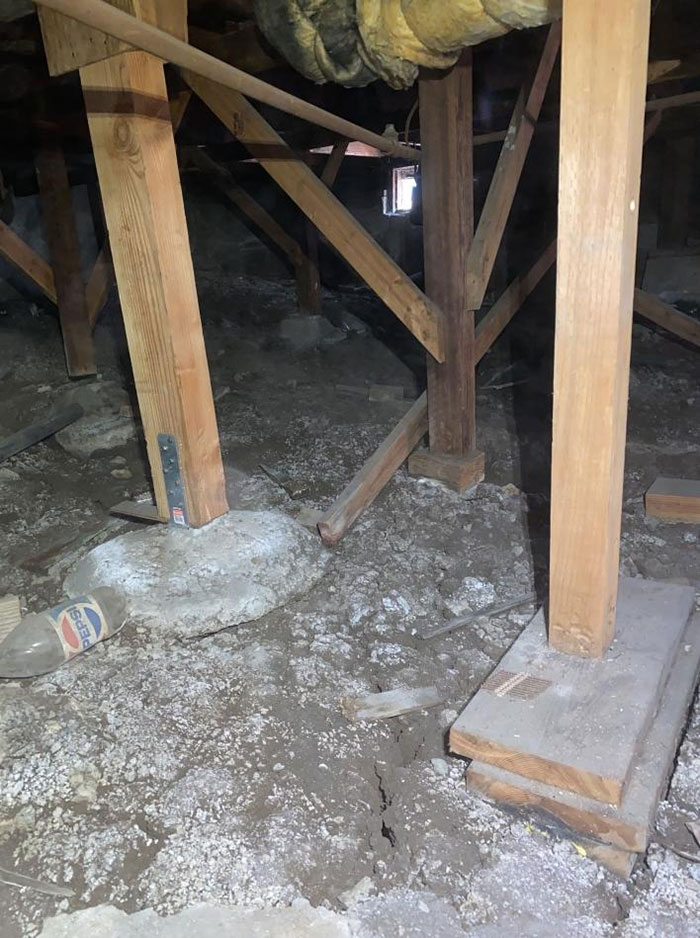
Image credits: AlphaStructural
#52
Omelets anyone?
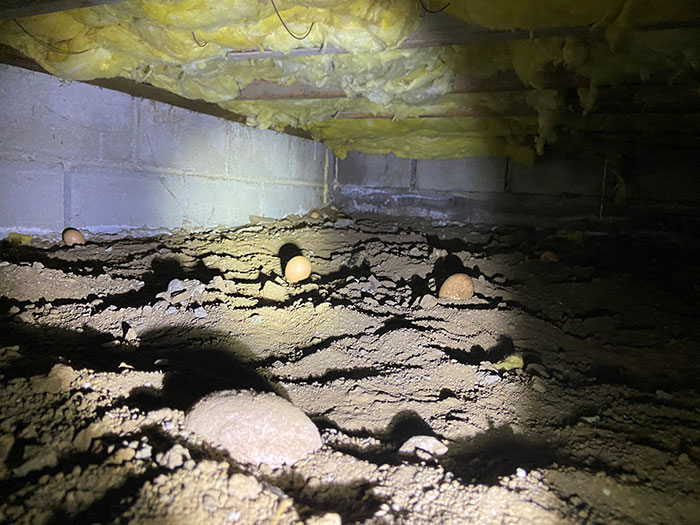
Image credits: AlphaStructural
#53
I think the L stands for load-bearing.
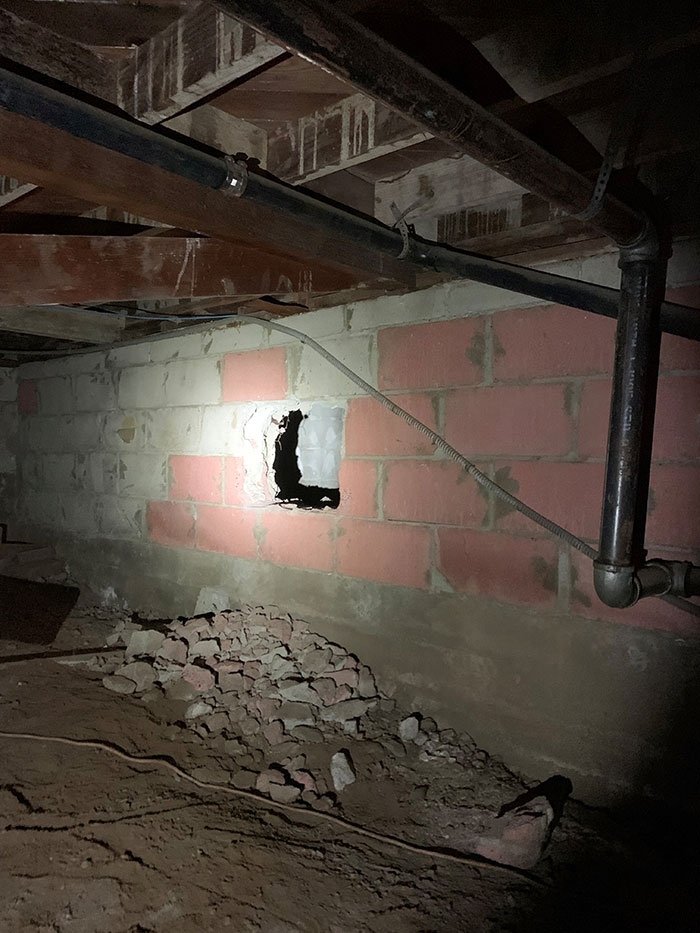
Image credits: AlphaStructural
#54
Make sure to hold the rai... irrigation pipe on the way down.
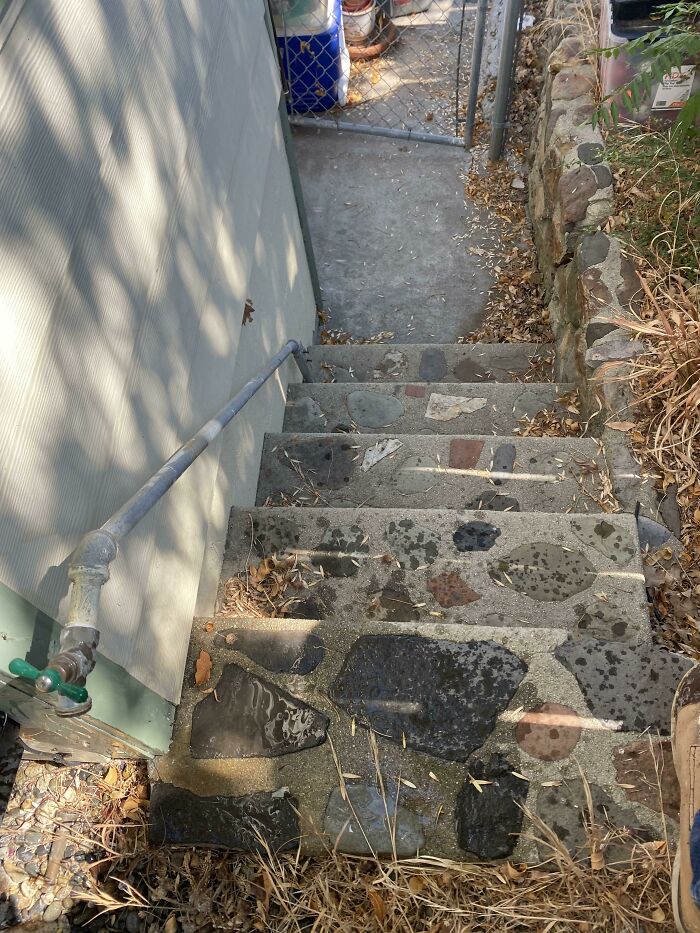
Image credits: AlphaStructural
from Bored Panda https://bit.ly/2Z3WY6u
via Boredpanda